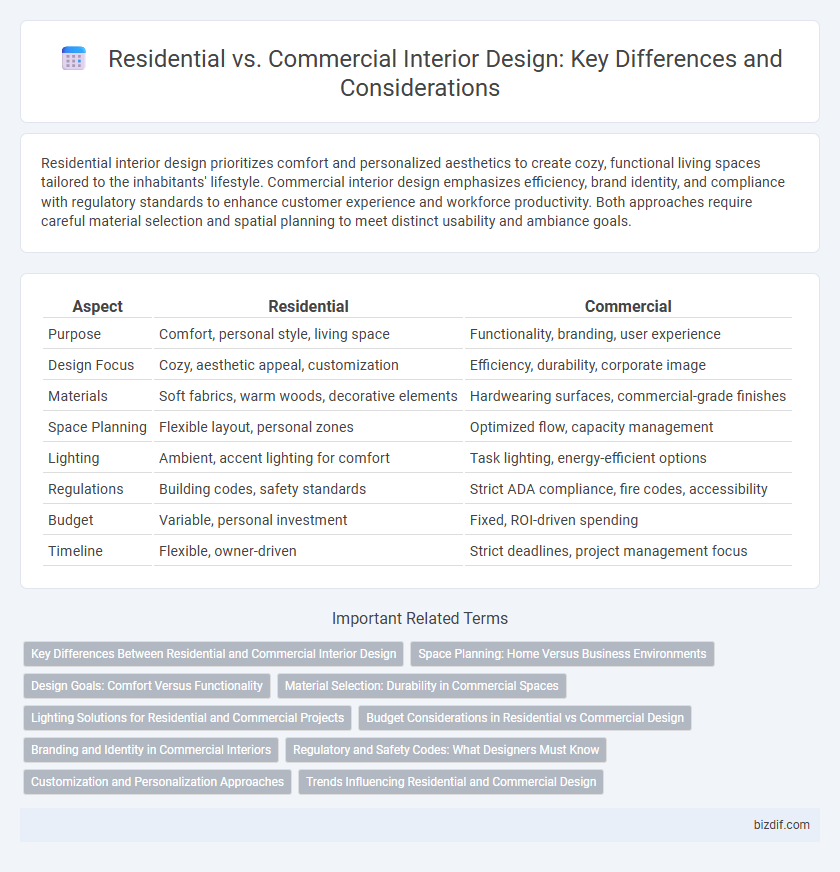Residential interior design prioritizes comfort and personalized aesthetics to create cozy, functional living spaces tailored to the inhabitants' lifestyle. Commercial interior design emphasizes efficiency, brand identity, and compliance with regulatory standards to enhance customer experience and workforce productivity. Both approaches require careful material selection and spatial planning to meet distinct usability and ambiance goals.
Table of Comparison
| Aspect | Residential | Commercial |
|---|---|---|
| Purpose | Comfort, personal style, living space | Functionality, branding, user experience |
| Design Focus | Cozy, aesthetic appeal, customization | Efficiency, durability, corporate image |
| Materials | Soft fabrics, warm woods, decorative elements | Hardwearing surfaces, commercial-grade finishes |
| Space Planning | Flexible layout, personal zones | Optimized flow, capacity management |
| Lighting | Ambient, accent lighting for comfort | Task lighting, energy-efficient options |
| Regulations | Building codes, safety standards | Strict ADA compliance, fire codes, accessibility |
| Budget | Variable, personal investment | Fixed, ROI-driven spending |
| Timeline | Flexible, owner-driven | Strict deadlines, project management focus |
Key Differences Between Residential and Commercial Interior Design
Residential interior design prioritizes creating comfortable, personalized spaces that reflect the homeowner's lifestyle and tastes, often incorporating softer textures, warmer color palettes, and functional layouts suited for daily living. Commercial interior design emphasizes durability, compliance with safety regulations, and maximizing operational efficiency, using materials and designs tailored to high-traffic areas and professional environments. Key differences include the scale of projects, design objectives focused on aesthetics versus functionality, and adherence to strict building codes in commercial spaces.
Space Planning: Home Versus Business Environments
Residential space planning emphasizes comfort, functionality, and personal lifestyle needs, optimizing rooms for relaxation, socializing, and private activities. Commercial space planning prioritizes efficiency, traffic flow, and regulatory compliance, ensuring workspaces accommodate employee productivity and customer accessibility. Design strategies differ significantly, with residential layouts promoting coziness and flexibility, while commercial environments require structured zoning and clear navigation.
Design Goals: Comfort Versus Functionality
Residential interior design prioritizes comfort, warmth, and personal expression to create inviting, livable spaces that reflect the occupants' lifestyles. Commercial interior design emphasizes functionality, efficiency, and durability to support business operations and accommodate high traffic. Balancing aesthetic appeal with practical needs ensures spaces meet specific user requirements in both residential and commercial environments.
Material Selection: Durability in Commercial Spaces
Commercial interior design demands high-durability materials like reinforced vinyl flooring, quartz countertops, and stainless steel fixtures to withstand heavy foot traffic and frequent use. In contrast, residential spaces often prioritize aesthetic appeal and comfort with materials such as hardwood flooring, marble surfaces, and softer textiles. Selecting materials for commercial environments requires balancing toughness, ease of maintenance, and compliance with safety regulations to ensure longevity and sustained performance.
Lighting Solutions for Residential and Commercial Projects
Residential lighting solutions prioritize warmth, comfort, and ambiance by incorporating layered lighting with dimmable fixtures and accent lights to enhance living spaces. Commercial lighting emphasizes energy efficiency, durability, and uniform illumination through LED panels, motion sensors, and task lighting to optimize productivity and safety in work environments. Effective lighting design in both residential and commercial projects integrates natural light with artificial sources to achieve functional and aesthetic balance.
Budget Considerations in Residential vs Commercial Design
Residential design budgets typically prioritize personalized aesthetics and comfort, often allowing for flexible spending based on individual preferences and lifestyle needs. Commercial design budgets focus on functionality, durability, and compliance with regulatory standards, requiring careful allocation toward materials that withstand high traffic and meet safety codes. Cost efficiency in commercial projects is critical, with an emphasis on long-term value and return on investment, whereas residential budgets often accommodate more customization and unique design elements.
Branding and Identity in Commercial Interiors
Commercial interiors play a crucial role in reinforcing brand identity through strategic design elements, color schemes, and layout that reflect the company's values and market positioning. Unlike residential spaces, commercial interiors prioritize customer experience and brand consistency to create memorable and impactful environments that drive engagement and loyalty. Effective branding in commercial design can differentiate businesses in competitive markets, enhance corporate image, and support marketing goals.
Regulatory and Safety Codes: What Designers Must Know
Designers must navigate distinct regulatory and safety codes when working on residential versus commercial interior projects, as commercial spaces often require compliance with more stringent fire safety, accessibility (ADA), and occupancy regulations. Residential designs prioritize building codes that focus on habitability, egress, and electrical safety tailored for private living environments. Understanding these specific code requirements ensures safety, legal compliance, and functionality tailored to the use and scale of the interior space.
Customization and Personalization Approaches
Residential interior design emphasizes customization and personalization by reflecting the unique lifestyle, tastes, and preferences of homeowners through tailored color schemes, furniture choices, and spatial layouts. Commercial interior design prioritizes functionality and brand identity, often incorporating customizable modular elements and flexible spaces to accommodate various business needs while enhancing customer and employee experience. Both approaches leverage advanced design software and materials to create environments that balance aesthetics with practical usability.
Trends Influencing Residential and Commercial Design
Residential design trends emphasize sustainable materials, smart home technology, and personalized spaces that reflect individual lifestyles, while commercial design trends focus on flexible workspaces, biophilic elements, and advanced lighting to enhance productivity and employee well-being. Integration of multifunctional furniture and eco-friendly solutions is driving innovation in both residential and commercial interiors. The growing demand for wellness-centered environments shapes design principles, promoting air quality, natural light, and ergonomic layouts across sectors.
Residential vs Commercial Infographic

 bizdif.com
bizdif.com